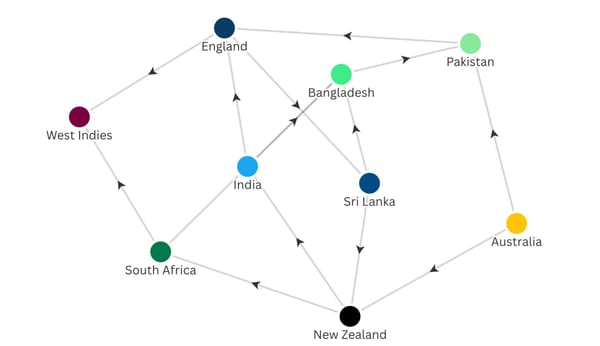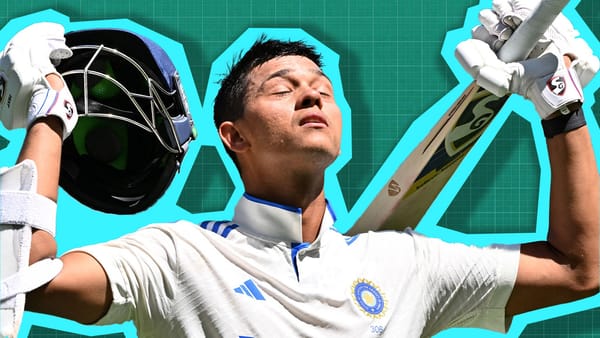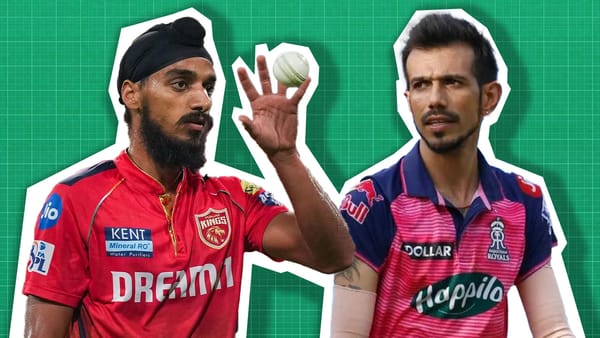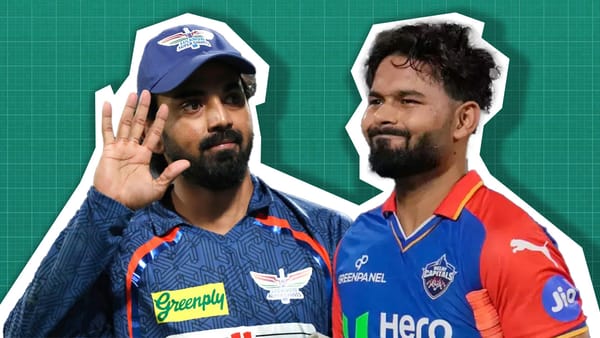The Fake IPL & the history of cricket's grift
A feature on cricket's long history with money, corruption and betting.
Efimov did something remarkable; he managed to get Russians watching cricket. Men drinking in pubs across Tver, Voronezh and Moscow were following the Indian Premier League.

Cricket in Russia is not big. In 2019, the Ministry of Sport refused to recognise the game officially. That was eventually overturned, and the ICC allowed Russia membership to play T20 internationals. Then they suspended them. There is a Moscow cricket academy and many expats trying to keep the sport alive.
It did once thrive there. Cricket was played in St Petersburg as far back as the 1870s, and matches were regular until the Bolsheviks took over. They decided cricket was elitist.
But chances are the blokes in the pubs weren't aware of this, and just wanted to gamble on something live in a good time slot. So Efimov provided them with cricket. Just not the one he was pretending it was.
New #ESPNDaily, with the great @ajarrodkimber:
— Pablo Torre (@PabloTorre) 1:30 PM ∙ Jul 28, 2022
How a gloriously *fake cricket league* in India scammed gamblers around the world 🚨🕵️♂️
And how all of it actually fits into cricket’s long, long history of British colonialism — and absurd grift
🎧🏏 open.spotify.com/episode/33WmHP…
Ted Pooley was supposed to be England's wicketkeeper in the match now known as cricket's first Test. Instead, he was in a Christchurch jail.
This weird occurrence started because of an injury that kept him out of tour matches in New Zealand. Because he couldn’t play, he offered to umpire. The problem was, that while he was out in the middle controlling play, he had also bet on the same game.
Pooley also won a lot of money for those bets. But the local bookmaker decided that because of this, he shouldn't pay out. Pooley was arrested for attacking him.
This was not a one-off. Betting on cricket was so much part of the game, that when it moved from a street and park pastime to a professional sport, the laws were written around gambling. Cricket's original rules were part of an oral tradition, but from 1744 they were codified and then eventually written down as laws. At that point, there were no major cricket organisations, and the Hambledon cricket club was the main cricket venue.
And in no other way was Hambledon a big deal. It’s not in London, and in days before cars, not even that close. Nor is it on the coast, or part of a city. But the games got big there because of the amount of gambling that they allowed in what ended up being a near non-stop festival of the elites drinking, betting and watching cricket.
The laws were shaped by this sporting old timey posh Las Vegas.
Obviously the players were involved, like when Thomas White used a bat the size of the wicket, but the model of Hambledon was to get maximum revenue from each match.
When it comes to money and cricket, these things are often glossed over in the early part of the game’s history. We pretend people played for the love of the sport, but there was always a business around it.
Even early cricket heroes, the amateurs, were about money. Unlike other sports, there was no split between the two. Many teams were made up of players from both classes. But the professionals were paid a job, and the amateurs were not.
Except, many of them were actually paid. Often more than professionals, especially on tours. WG Grace was by far the best-paid player in cricket. As he should have been, he was like Roger Federer, Michael Jordan and Serena Williams rolled into one package. But he was also - to use the phrase of the era - a Shamatuer.
The entire history of cricket is loaded with stories about money, and yet, the sport tries to purvey itself as the whitest sport. Literally. But the things like Hambledon haven, the Oval putting up gates and the IPL renaming a six for commercial reasons. Cricket has always been about money.
We currently call Efimov's creation, the fake IPL. But it really should be known as the Molipur Premier League in honour of the village that hosted it.
And that term obviously has some negative connotations in cricket. To refer to someone's game as ‘village’ is an insult.
There is no getting around it though, the Molipur Premier League (MPL) was certainly village.
Someone in Gujarat fooled a bunch of Russians willing to bet money on cricket matches by staging a fake IPL. This is not a joke.
— Brut India (@BrutIndia) 2:07 PM ∙ Jul 13, 2022
In proper cricket, umpires call wides based on guidelines marked between the crease. It makes them less of a judgement call. In the MPL they had little orange cones on the field. Why they didn't use paint, we will never know. There is no way a real league would ever have something like this on the ground. Not only are they trip hazards, but they could also stop the ball from travelling further.
You can see this on some of the footage from the MPL, which shows how random much of the cricket is.
There's a fielder directly behind the wicketkeeper, where he is supposed to be at slip, but his actual position is basically backstop. You do see this in children's matches when the kids struggle to stop the balls with gloves on, or you might see it all the way back on the boundary if you are bowling short and fast.
The bowler is doing neither of those things, and the fielder is supposed to be a slip. At this pace the only way a delivery would make it would be if the batter picked it up and threw it. And most edges wouldn't get to slip, even along the ground, as he's almost completely behind the keeper.
The keeper himself doesn't have pads on. Some modern players use shin guards under their trousers to give them more flexibility. That does not seem to be the case here.
Also the technique of the keeper, it’s not good. He doesn't bend at the knees to start on the ground. Instead he's bent over, with his hands near his hips. This is how people keep when they have never played real cricket before.
He also doesn't move as the ball comes down like a glitching computer game character stuck in the same spot. If the ball was to go down legside, the slip/backstop is more likely to stop it. Oh, and he's not up at the stumps, but neither is he a long way back. He can't stand at the stumps because he clearly has no idea how. No professional would ever stand in this position.
The bowler is not great either. His run up is five paces, which is on the low side for seam up. He starts wide, immediately comes in towards the stumps and then goes wide again. He's bowling slow-medium pace and looks like this is the first time he's ever dealt with running past an umpire. His balls skid off the pitch a little.
That is probably because they are matting. Pakistan and South Africa used matting pitches for their internationals for a long time. But eventually, both moved to turf wickets, and in the last 50 years, no major international matches have been played on them. That's not to say they've disappeared. Some associate countries have used astroturf pitches, especially for women's games. But almost all cricket we watch on TV is on real turf, and has been for a very long time.
You know what else is unlikely? Having a bunch of balls out on the ground. In baseball, this would make sense, although it's doubtful they'd ever be in a pile near the pitcher's feet. But in cricket, where you use one ball for the entire game (unless you lose or break it), why would you need a collection of balls as a near-trip hazard for the bowler.
There is also the nice touch that the players wear specially made coloured cricket clothing, but still wear white pads. If you are going to hire a bunch of enthusiastic but essentially club-cricketing farmers to fake your league, at least pony up a few more dollars for coloured pads.
I think my favourite moment is when the ball is lofted in the air, always a moment of great intensity in a cricket match. Will it go for six, be caught, land safe. The tension can often be seen on the faces of batters and the bowler. But from our MPL friends, you see a gentle walk in the park from one end to another, and then the ball gets softly passed back to the bowler. Did it bounce, was it dropped, we will never know.
The MPL is a whodunit, on and off the field.
In 1948, Australian opener Sid Barnes decided to back himself at Lord's. Literally. He placed a bet on the fact he would make a hundred in the next Test, and then he went and did it. Over 30 years later at Headingley, England were getting crushed by Australia and the bookmakers at the ground offered odds on the home side at 500-1. Two Australian players, Dennis Lillee and Rod Marsh put what they called a "joke" bet down of 15 pounds.
This was the 905th Test match. In the previous 904, only once had a team overcome a follow-on, and that was in the 1800s. But that is what England did, in what was at that point perhaps the biggest comeback in cricket history. That Test has a movie and book about it, and the bet is often laughed off as Aussies having a bit of fun.
It's worth noting that England’s Graham Dilley - who made a handy 50 down the order as Ian Botham swung away - said, "The bet just put an element of doubt in my mind, even though I knew nothing dodgy had happened."
For the record, Lillee took three wickets in a poor bowling display but was third top scorer with the bat.
Both the 1948 and 1981 bets were seen as Aussies having fun at the time. And there are certainly other stories of players making bets in cricket for fun. Especially when bookmakers were allowed inside the ground.
But there is another side of this that goes back to the home of cricket, Lord's. William Lambert was an incredible batter and the second biggest star in the game. In 1817 he was the first player to make two hundreds in a first class match. That same year he was found guilty of match-fixing.

It was really after Headingley in 1981 that betting on cricket went from a laugh to corruption when Salim Malik, Hansie Cronje and Mohammad Azharuddin were all suspended for match-fixing around the year 2000. All of them were not only respected senior players, but had been captains of their national sides.
And from that match-fixing cluster, the cloud never really went away. It peaked in 2010 when an English tabloid caught Mohammad Asif, Mohammad Amir and their Pakistani captain Salman Butt spot-fixing at Lord's. 193 years after the first occasion.
Corruption in cricket is much more confusing because it's a truly international sport. The ICC believed Salman Butt was fixing before he was caught. But they are not Interpol and working out how to prove it was very tough. Some people believe at the 2007 World Cup in the West Indies, the Pakistani player was using English and Indian mobile phones. If you count all the islands he went through, and we're talking at least six jurisdictions.
While most major cricket nations are commonwealth members, these countries are nothing alike. Gambling is illegal in many cricket nations. Yet Melbourne - home of the first Test - has a holiday for a horse race.
While betting is mostly illegal across the subcontinent. Sri Lanka regulated it in 2010, though it should be said it was certainly fairly open within the country before. But India, Bangladesh and Pakistan all don't allow betting on cricket. Nepal is the same, Afghanistan has interesting rules when it comes to online gambling, but the Taliban are obviously not fans of it.
But you can’t really stop gambling, you can just make it illegal. It was an open joke that most US sports fans betted for generations despite betting not being legal in the majority of the country. Sports fans - and certainly the cricket ones - are going to gamble. No law is going to stop that.
Cricket is a sport built around betting while having his extensive illegal gambling system behind it. Even the legal betting companies are fed up with the illicit markets that are often controlled by organised crime. They help the ICC and cricket boards with irregular markets that could come from fixing. Because they also don't want to be ripped off.
All of this creates a bizarre situation where this sport grew on the back of gambling, and as it did, that meant it found new locations that didn't allow betting. And the combination of those two worlds seems to have created a near-perfect sport for gambling corruption.
An episode of Aaron Sorkin's Sportsnight discusses a fictitious cricket event of a bowler taking all ten wickets in an innings. Part of the running joke in the entire episode is that no one knows anything about cricket in America. But there is also a great visual gag.
A bunch of random images are shown on the screen in a short period. Bowler, batter, fielder, crowd, and boundary all juxtaposed like an Eisenstein montage.
Think back to a lot of cricket you watch, say a leg bye that ends up going to the boundary. We see someone get hit, then the ball is on grass, a bowler being frustrated as two men run pass him in opposite directions, the ball hits the rope, the crowd cheer, an umpire does sign language before standing on one leg, and two grown men fist bump with gloves on.

Much of what we see on TV is a collection of images that only a cricket fan could make sense of. The visual language of cricket is bizarre.
Even a few years ago, cricket was almost exclusively a big TV production. Hugely expensive long lens cameras aimed down at the cricketers, with many others around the ground picking up the action. Then streaming happened, and with it came the ability for anyone with a stable internet connection and a camcorder to show their games to the world.
It started with first class matches like the Sheffield Shield in Australia and then County in the UK. Soon most cricket had some kind of one camera set up for steaming. Then places like Cricket District started popping up, essentially showing clips from funny club moments. We also the European Cricket League, a tournament that was livestreaming club matches from around Europe to the world.
Cricket used to look very professional when made by a big TV network, and now it is increasingly one handycam, and maybe a couple of other angles to follow the ball.
The look of the MPL is bad, but in today's world, it doesn't stick out as much as it should. They had more than one camera helmed by professionals, hired video graphics designers, and had a commentator (who was impersonating Harsha Bhogle) telling the punters to bet.
When a ball was hit up you'd get a sky shot, and the umpire calling a six. They ensured never to get too close enough to players lest the bettors work out they were fake. Probably an unnecessary detail, but even still.
The footage to a cricket fan is hardly convincing. But the people watching weren't that. If you know nothing of the game, they are wearing the colours, there is a camera, graphics, the ball is moving around and an upbeat man with a pleasant demeanour is calling the action. Clearly that was enough.
Remember, when it comes to betting, people do wager on weird things, like the animated horse racing programs that are clearly fixed beforehand. This at least had humans and a camera angle that replicated what cricket looks like. Or a good enough facsimile.
There were two rich media moguls in Australia in the 1970s, one went on to conquer the media world, and his life is now fictionalised in a HBO drama called succession. The other was Kerry Packer. The two men both inherited sizeable businesses from their fathers, but while Rupert Murdoch went large, Packer stayed at home and dominated the Australian TV market.
But as powerful as he was, he still had to handle local bureaucracy, and one of those regulations was to show a large percentage of Australian-made TV shows. It's why there are so many popular Australian children's shows worldwide, like Bananas in Pyjamas, The Wiggles and Bluey. These are cheap to make and easy to produce in bulk.

Packer wanted something similar, and as a huge cricket fan, he knew how many hours the game could take up on TV. So after trying to buy the rights legally, and being rebuffed because he couldn't broadcast nationally and the boards liked their deal with ABC, he just started his own league, World Series Cricket.
A completely made-for TV product, that was tweaked to make it sexier, and crucially, played in prime time rather than the middle of the day. Packer essentially bought the majority of Australia's best cricketers and then did the same with other teams like the West Indies. He also cherry-picked the best players worldwide, paying them huge amounts.
Richard Austin was a struggling West Indian player in and out of the team. He would receive 74USD for appearing in a Test. He only played in two. Packer gave him a two-year 20,000USD contract.
Despite the fact Packer loved cricket, and wanted it broadcast better, he didn't want to run the game. So Cricket Australia gave him the TV rights to end the conflict, and he left the game in an official sense.
Austin wasn't just paid by Packer though; he also received another payment of 100k USD to go on a tour. Sadly that one was to play in Apartheid South Africa on what is called within cricket, the Rebel tours. Unofficial Australia, England, Sri Lanka and the West Indies teams sent professional cricketers over during the sporting bans. They were playing for cricket-starved crowds after South Africa was ostracised from the sport.
So these players were again easy pickings, as they had been for Packer, because they were paid terrible money. Cricket had good finances, but that money never trickled down, which allowed for players to be bought off. (See also, match fixing.)
The entire thing would happen again with the unofficial Indian Cricket League, buying up some of the biggest names in cricket. And again a few years later with a failed World Test League.
Cricketers have never been paid their true worth, meaning they are nearly constantly able to be bought.
The MPL was supposed to run a long time. The land had been leased for a year, and the scam was to last at least that long. There were agents in Russia and India working behind the scenes. At the Indian end, it was all looked after by a man who used to work in an electronics store who'd lost money on a buffalo dairy business.
The farmers and unemployed people were recruited as players and paid 400 Rupees a day. It would be unfair to say they couldn't play the game, but clearly they were of a low level. They were trained on how to look like professional players, including proper techniques, and even the umpires had classes.
A local farmer was offered more money than he’d ever make in a year from crops for the rental of his land. They turned his field into a cricket ground.
There was a fake crowd noise that was piped in with a PA system they bought. Messages on what was to happen next in the ball were sent to the umpires, who had walkie-talkies (just like in real life) that were directing the play to milk the gamblers.
Even the people betting were trained. An online course to explain how to bet on cricket was made by the MPL founders. They did more work than Kevin Costner in field of dreams.
Four people were arrested in the first instance, but many others have been named, and police are still working on catching more. The original charges were for criminal conspiracy.
Many believe the Lord's press box looks like a UFO, but it was the helicopter that landed behind it that was more out of this world.
Inside was Allen Stanford, a billionaire who claimed to be related to the Stanford University family. He had splashed money all around the Caribbean and was even given a knighthood. He also did a similar thing to Kerry Packer, essentially creating a new cricket tournament, but this time with some help from the Cricket West Indies board.
Like Packer he wanted to sex cricket up with big money prizes and black bats. But the reason he was at Lord's was to confirm a partnership with the English (and Wales) cricket board for a match between them and his Stanford All-Stars. The winner would take home 20 Million dollars, which he showed in a big plastic box at Lord's.
Sadly the money in the box was fake, twice.
The imitation bills he showed were very similar to his own fraudulent wealth on the back of a massive ponzi scheme. He's currently serving a 110-year sentence.
The UvaT20 League was going to have Tillakaratne Dilshan, Farveez Maharoof, and Ajantha Mendis star during the height of lockdown. A host of major Sri Lankan companies were sponsoring as emails from Sri Lankan cricket officials were sent around promoting the event.
The major problem was that none of those players were involved, the game wasn't in Sri Lanka and the police in the Indian city of Mohali were about to shut it down. The entire thing was a scam tournament with Indian players pretending to be in Sri Lanka. Organised by a fixing syndicate who were hit as hard by covid as everyone else.
That happened in 2020, just a few days ago there was the Big Bash Punjab T20, a tournament played in Meerut. Some of India's best Ranji players were involved. The matches were live streamed on YouTube. And cricket fans from around the world could watch and enjoy.
It was another scam, from the same group that did the MPL. Police now suspect a widespread criminal conspiracy across different parts of India with these fake leagues.
Cycling, athletics and baseball had major sandals as people cheated to win. In cricket, we cheat to lose. In other sports, betters wager on them, in cricket, gamblers built it. They call it the gentleman's game, promote the all-white clothes, and break for tea. But at its core, if you are paying attention, cricket has always been the grifter's game.
It might be the fake IPL, but it’s the true story of cricket.




